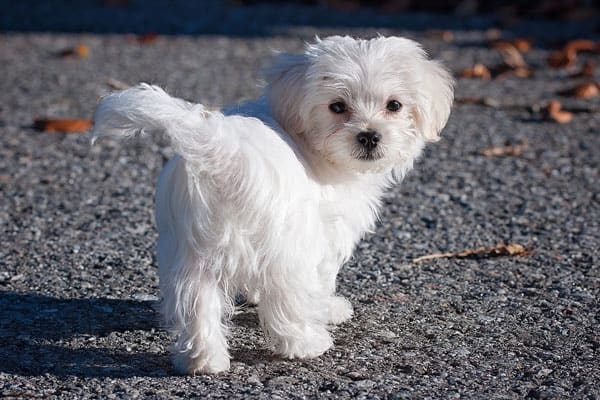When Do Maltese Stop Growing: What to Expect As Your Puppy Grows Up

In the world of purebred dog breeding, there are five major size categories: giant, large, medium, small, and toy. Maltese are considered a true toy dog breed.
Some breeders will go even smaller and breed teacup Maltese, but this is not a recognized purebred size category for show competition purposes.
For people new to the Maltese breed, it is hard to imagine how small such a tiny dog could be when they are first born! In this article, learn about the Maltese growth process and find out when Maltese puppies stop growing.
When Do Maltese Stop Growing?
While some owners state that their Maltese puppies had finished growing by the age of eight months, PetMD says that 10 to 12 months is more typical.
As Whelping Puppies explains, in most cases, a Maltese puppy will grow quite slowly until around 12 weeks (three months) of age.
After that time, the growth typically speeds up noticeably, and the puppy finishes most of its growth by 10 to 12 months.
Watch a Maltese Puppy Grow Up
In this short and sweet owner video, you can watch a tiny eight-week-old Maltese puppy grow up through eight months of age.
Because the Maltese is a toy dog breed, these dogs tend to grow up quite quickly, as you will notice.
And in fact, there isn’t a lot of growing size-wise to do past a certain point, but other important growth-related changes are occurring, such as the development of the adult coat and the transition from puppy teeth to adult teeth.
Maltese Puppies Grow More Slowly Than Other Breeds
According to the American Maltese Association (AMA), Maltese puppies grow so slowly in the first few months of life that AMA-associated breeders pledge not to let new owners take puppies home before the age of 12 weeks (three months).
This is quite unusual, especially in an era where the reigning school of responsible puppy breeding is retaining a puppy until the age of eight to nine weeks.
But the Maltese have an unusually slow growth rate in those first critical few weeks of life due to this dog’s extremely small adult size. These puppies rarely weigh even seven pounds fully grown, according to the American Kennel Club (AKC).
Keeping a puppy longer with its mother and littermates ensures two critical needs are met in full: the puppy gets the nourishment of the mother’s milk for longer, and the puppy gets the vital socialization of being with the mother dog and the littermates for longer.
Because Maltese dogs are known to be stubborn and slow to learn obedience and potty training skills, this extra socialization time in the litter helps to make for the best possible experience for the new Maltese owner.
Learn About the Stages of Maltese Puppy Growth
So what are the typical stages of a Maltese puppy’s growth chart? Let’s take a closer look.
Newborn puppies
According to Maltese Mystique breeders, each newborn Maltese puppy will weigh between two and six ounces at birth. The average smartphone weighs around four to six ounces. So that is a really small puppy!
Two weeks old
A two-week-old Maltese puppy will be starting to open their eyes and weigh as much as 10 ounces.
Three weeks old
At three weeks old, a Maltese puppy will start to move about more and explore its immediate surroundings.
Four weeks old
At four weeks old, a Maltese puppy will become more mobile and social and may weigh up to 11 ounces.
Five weeks old
At five weeks old, a Maltese puppy may be starting to get their baby teeth in. Their weight will likely have doubled from their birth weight, and they will be more interested in moving and playing.
Six weeks old
At six weeks old, a Maltese puppy is starting to play with puppy toys and with their littermates and is awake for longer.
Seven weeks old
At seven weeks old, a Maltese puppy is starting to exhibit more coordination as a result of sibling playtime and exploration.
Eight weeks old
At eight weeks old, a Maltese puppy is beginning to show an active interest in people and will have an abundant curiosity about the people around them.
Nine weeks old
By the age of nine weeks old, most puppies of other dog breeds are all set to go to their new forever homes. But Maltese puppies will stay with their mom and littermates for an additional three weeks.
By nine weeks old, a Maltese puppy will have nearly doubled in weight again and can weigh up to 16 ounces (one pound). In comparison, an adult Maltese dog may weigh anywhere from four to seven pounds.
10 weeks old
By the age of 10 weeks old, a Maltese puppy may weigh up to a pound and a half and have a full set of puppy teeth. They are playing and rough-housing with their siblings and becoming more athletic.
11 weeks old
At 11 weeks old, a Maltese puppy is beginning the journey towards potty training in earnest, learning to use pee pads and chewing everything in sight.
12 weeks old
By 12 weeks of age, it is finally time for the still-little Maltese puppy to head to its new forever home. They may weigh anywhere from 1.5 to two pounds and will have longer coats and better muscle coordination.
So this gives you a great idea of all the changes your Maltese puppy has to go through in just the first three months of life. Because these dogs are so little, even as adults, the changes are less visible but just as significant.
Potty Training a Maltese Puppy
According to DFW Maltese breeders, potty training a Maltese puppy doesn’t have to be as difficult as some owners and breeders make it out to be.
The key to success is consistency – yours as well as your puppy’s.
Your Maltese puppy will likely come to you already familiar with puppy pads. Many Maltese breeders begin potty training by using puppy pads for the simple reason that a Maltese puppy’s bladder is so tiny there is little room for error.
It can be easier to train a Maltese puppy to take a few steps over to a puppy pad than to run all the way to the door, make an alert to be let out and then go. Most Maltese puppies simply cannot hold it that long.
A big part of consistency in Maltese puppy potty training is identifying times when your Maltese puppy will always need to go out (or stay in and use a puppy pad).
Here are the most common times when a Maltese puppy must relieve themselves:
- Right after waking up in the morning.
- Right after a nap.
- Right after a meal.
- Right after drinking water.
- Every two hours.
- Right before bedtime.
- After any session of play.
For general purposes, plan to let your Maltese puppy relieve themselves every two hours if not sooner. This can mean setting your alarm and waking up during the night when your puppy first comes home.
You can take away the water dish a couple of hours before bedtime to try to extend that first period of nighttime rest by an hour or two. But if you hear your puppy crying at night, there is a good chance it is because they need to relieve themselves.
Over time, and certainly by the age of one-year-old, with careful management of food and water, your Maltese should be able to make it through the night without a bathroom break.
When your Maltese puppy has a potty accident in the house, it is not useful to scold them. It is quite likely your puppy just couldn’t hold it. Rather, praise your puppy every time they go on cue.
The Special Challenge of Maltese Hypoglycemia
One more unusual thing about choosing such a tiny dog breed is that the Maltese can fall prey to low blood sugar (hypoglycemia).
As McHenry Maltese Puppies breeder explains, Maltese puppies have such small stomachs it can be hard for them to eat enough to maintain their blood sugar between meals.
Using a fortified supplement like Nutrical can help maintain blood sugar levels between meals. Your breeder will be able to tell you what they have been using and how to dose it so you can continue doing this after your puppy comes home.
You will want to keep emergency honey or Caro syrup (or whatever your breeder recommends) so you can give your Maltese puppy some quick nourishment if the need arises.
The Maltese dog breed fully grown is surprisingly hardy. But puppyhood can be a fragile time, and it is important to know what to expect.






